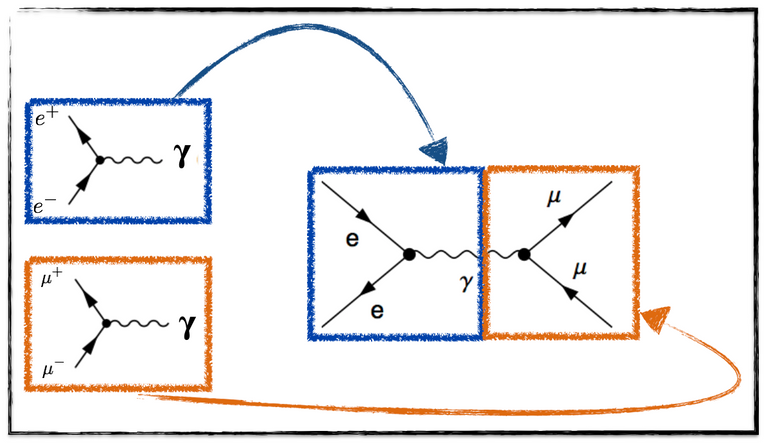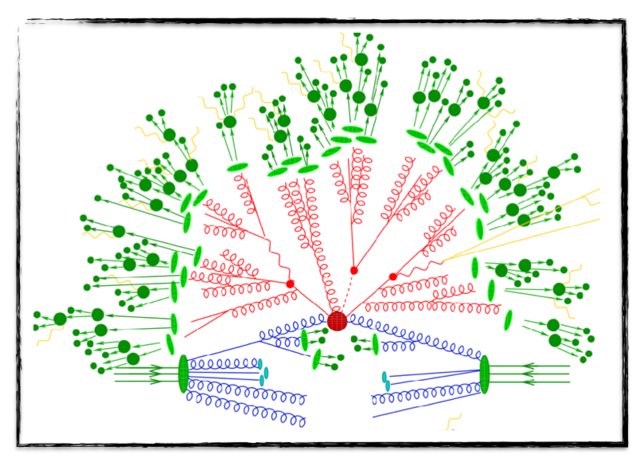Our meetup where steemSTEM (and thus STEEM) will go underground to see the Large Hadron Collider at CERN, in the area of Geneva, is in slightly more than two weeks from now (on February 9th).
I am thus left with not so much time to finalize this series aiming to prepare the participants to what they will see. The good news is that only very few episodes are left to be written.

The transparencies that I will present at the meetup are available on my google drive and cover mostly what I said in these posts (there is of course extra stuff, to make it funnier).
In the first two posts of this series, I have described how matter is structured at its most fundamental level (see here) and how the interactions of the fundamental particles work (see here). In the previous post, I have finally introduced why we needed to add a Higgs boson to the theory (see here).
In this latter article on the Higgs boson, I have in particular mentioned that the discovery of the Higgs boson was originating from the comparison of theory predictions with accurate-enough experimental data. This post is dedicated to the first of these two items. I will explain how the predictions can be made from the Standard Model of particle physics, in a few words of course.
THE STANDARD MODEL CUP (OR LAGRANGIAN)
As a high-energy theorist, my goal in life (yeah really) is to make predictions that can be tested experimentally. In the previous posts of this series, I have described the ingredients underlying the Standard Model. However, how to make predictions?
This is the topic of the day.

[image credits: CERN shop]
The particles that I have introduced in the previous posts, the way they interact and the Brout-Englert-Higgs mechanism all fit within a very compact quantity: the Standard Model Lagrangian.
I will not give the equation myself, but just say that it is so elegant that it fits on a cup (see the figure). Bonus, there are two mistakes on this cup (that can be bought at CERN by the way). Don’t hesitate to try to find them ;)
And this Lagrangian is the key player. From it, we can calculate the production rates of this or that particle at the LHC, we can evaluate the sensitivity of an analysis to a new physics signal, and so on.
One very cool way to make those predictions is to rely on Feynman rules. These consist in diagrams that can be extracted from the Lagrangian, and there is one diagram for each interaction of the model.
I give an example with electromagnetism below.

The Standard Model Lagrangian includes, among others, Feynman rules corresponding to:
- the electromagnetic interactions of the electron (the electron-positron-photon interaction in blue, on the top left),
- the electromagnetic interaction of a muon (the electron-positron-photon interaction in orange, on the bottom left).
In order to calculate, for instance, a rate, it is sufficient to draw all the possible diagrams connecting a given initial state to a given final state. It is at the end just a game! Nothing more nothing less!
For instance, in the picture above, I show the diagram describing how a muon-antimuon pair can originate from an electron-positron collision. The diagram is made by rotating the orange rule and gluing it to the blue one. That’s it.
However life is not that nice. For getting correct predictions, we need to find all the diagrams. One is missing, and we are totally wrong (not even partially correct).
At the end, we can think it should be possible to design an algorithm that does it. One tries cleverly all possibilities and we should get fine. And then, we can teach it to a computer… :)
Too late for this. There are actually already several (open access and open source) computer codes doing those derivations for us.
FROM FEYNMAN RULES TO LHC COLLISIONS
From the set of Feynman rules, we can write some integrals, that consist in the stuff to calculate to get LHC predictions. Those integrals are not easy, as they are highly multidimensional and cannot (most of the time) be solved analytically. However, numerical methods work well (computers again).

[image credits: Super-spread HEP picture]
But the story does not end here. The entire collision picture is much more complicated than just getting some little diagrams. This is illustrated on the figure on the right.
The Feynman rules as depicted above only allow for computing the red blob in the middle of the figure.
We are indeed at the LHC, a strongly- interacting environment where highly-energetic particles are present and are produced. Those particles have the properties to radiate other strongly-interacting particles. Life becomes messy. This is the extra red stuff on the picture.
However, this can be calculated with Feynman rules (and other stuff too).
Our strongly-interacting particles will eventually form composite states (the green stuff), which we have phenomenological models that work pretty well for. Finally, these composite states consist in what we will detect under the form of hits and tracks in a detector.
The good news is that we have computer programs to handle everything. The super good news is that we even have programs to change the cup and insert another one at the very top of the chain. And finally, we also have program that helps to analyze what is going on at the end of the chain.
In summary, we are well equipped :p
SUMMARY
In this post, I have tried to briefly explain how to make predictions within the Standard Model. I introduced the Standard Model Lagrangian (without really saying what it was :p) and sketched how to make predictions with it (in particular with Feynman rules).
In the next post, I will turn on how signals are recorded in a detector.
The associated slides are available on my google drive. More information can be found in this textbook, among others.
SteemSTEM
SteemSTEM is a community-driven project that now runs on Steemit for more than a year. We seek to build a community of science lovers on Steemit and to promote well written/informative Science Technology Engineering and Mathematics (STEM) postings in order to make Steemit a place for fascinating STEM content.
More information can be found on the @steemstem blog and on the Steemit chat and in our last project report.
I can wait to read your next post as the only thing i know about how signals are recorded is through magnetic electronic waves.
You will have to wait for next week. I can't write more than 1 post a week at the moment... Too much work. You will see that things are more complicated with particle physics detector. :p
Ok next week it is.
Definitely :)
cool post. The trip to the CERN is going to be great - would love to go. But looking forward to seeing the pictures.
Maybe for the next time :)
Dear Lemouth, I am following you regularly from few days and your writing skills are excellent. In this article you have described this topic "how matter is structured at its most fundamental level" very nicely! I am going to share this with my sister (school Teacher) on Facebook! I know she's gonna love this .

The link you have provided to your Google drive is not working! Every time I try to open the link it says, safari can't open this page!!! I have attached the screenshot.
Can you please send me the link here?
Thanks a lot for your nice message.
This is weird because I can open the link. Can anyone please double check this? Maybe is google blocked on your side? I can also drop the PDF elsewhere (on some CERNbox or dropbox).
But I just noticed this is the old version of the slides. I am traveling at the moment and cannot thus fix this. I will take care of that from home, tomorrow. Sorry about that and thanks for reporting it to me!
Also Can you please tell me when you are going to write the next article?
No as I don't know it myself. Maybe tomorrow or on Wednesday ;)
can you please try with this link: https://drive.google.com/open?id=1kAPS26wq-zw1REjcS14i9yyQ9WgLXjUC
Thank you very much for updating the link. It's working fine now. I will text here after checking all of them.
It's working fine now. I will text here after checking all of them.
Thanks again
Amazing high quality content, again. - speechless
Thank you :)
The Lagragian equation would have made for a tough explaining to do. Glad you jumped it.
Actually it is easy to understand. The first line consist of gauge boson propagation and self-interactions. The second line consist of the fermions (the 12 particles/antiparticles introduced in the first course) interactions and propagation terms. The next term consists of the Higgs interactions with matter, and the last one of all other Higgs interactions. Now you know :D
Well, this explanation just made it a lot easier. It is good to know things :)
Glad you liked it ^^
I'm going to print out this series today and read it in paperback a few times.
The slides are not finished yet, by the way. I still need to add one part (next week, or never :D ).
But thanks for doing this anyways! :)
Just want to be as well informed as possible. I can also make more extensive copies if for others if that would be helpful and bring them with me for the group. Just let me know.
Maybe ask them directly on the chat?
Hummmm .This is pure computational Chemistry aspect of particle physics.Its for intellectuals.I salute you sir @lemouth .How is preparation towards.How is preparation towards Meetup @ C.E.R.N Sir
The meetup is basically ready :D
Sorry for the late reply, I've been rather busy lately.
But I'm bugging you on Steemit Chat now :P
I am more often on discord. I will appear soon or later (traveling today and tomorrow, sorry) :p
Oh my gosh, I am soooo jealous. I wish I lived near and could go to a Steemit meetup at the LHC. :( I am going to be following your posts closely. Physics is a subject I'm very passionate about (although I only got so far in college as to study relativity, time dilation and such.) I have an MS in Science Journalism, though I only occasionally write on those topics at the moment. I've been planning to go back and study some physics topics and relearn things I've forgotten, and I think you will be perfect to follow while I'm doing that. :) Glad I found you on here!
Maybe for the next time. The LHC will be shutdown for a long time next year, so that there will be plenty of opportunities to visit it ;)
In which area of science are you currently writing about?
Ohhh, I didn't know it was shutting down! Just looked that up. 18 months! But it sounds like they'll be doing some really important upgrades. I can't wait to hear what's discovered next. :)
I've gotten into more general reporting lately (politics, breaking news, TV) but I pick up science stories here and there if I can get them or if they're relevant to my clients. (But I'm not focused on one particular field.) I did one about Mars One a while back, talking to experts who really doubted that it was going to happen at all. And I wrote a lot about the gravitational waves discovery and put up a live stream of the announcement. :)
I used to live in Waxahachie, where we almost had the Superconducting Super Collider. I'm still bitter that project was shut down. :-/
Shutdowns are important for better restarting (and also fixing stuff in the detectors :)
I wrote as well a couple of posts on the gravitational wave stuff at that time (maybe in a slightly different way from what could be found elsewhere), In any case, don't hesitate to come to me if you need names for LHC stuff. I would be more than happy to redirect you to the proper places ;)
The SSC is indeed a sad story. All of this for a few airplanes... :(
That sounds great. I will definitely come to you for LHC info and names! :)
Astrophysics and cosmology works too, by the way ;)
I can't wait to learn how signals are recorded in a detector. I love physics. Thanks for making out time to attend to us all.
For this, you will need to wait for next week. I don't have the time at the moment to write more than 1 article every 3-4 days. In this way, I somehow teach patience as well :D